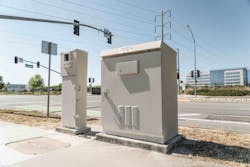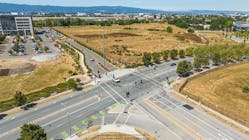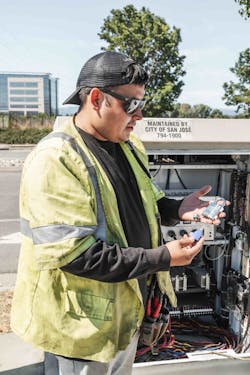Earlier this year, the Department of Transportation for the City of San Jose began a year-long installation program to replace and upgrade the security measures of their traffic signal and Intelligent Transportation System (ITS) cabinets. Seeking a leading-edge security solution, they determined after a thorough review that ASSA ABLOY Global Solutions – Critical Infrastructure had an access management system that exceeded their expectations.
“After contacting several possible vendor partners, we focused on a locking device that not only would be very difficult to access but something that was unique,” said Darren Thai, an associate engineer with the City of San Jose’s Department of Transportation for the last seven years. He is a member of the ITS group, which is responsible for connecting the city with the latest network communication traffic technology including surveillance cameras and video detection.
“ASSA ABLOY Global Solutions – Critical Infrastructure (AAGS-CI) offered more than we asked for in terms of flexibility, plus the whole validity process and permission sets in the management software. We are definitely happy and impressed with how things have progressed.”
Following a half-day training session with AAGS-CI’s system integration partner, Western Pacific Signal, installation of the 75481 series traffic enclosure lock has begun on 2,000 cabinets as part of the department’s implementation plan.
New technology begins in Silicon Valley
Known as the capital of Silicon Valley, San Jose is a progressive city and the largest in northern California. For three years in the mid 1800s, it functioned as the state’s capital. Now it is home to over 6,000 technology companies, and more cutting-edge developments originate there than anywhere else in the world.
Located on the southern edge of San Francisco Bay, San Jose has quickly grown to become the 12th largest city in the United States with almost one million residents. It is also the fourth largest city in California with a land size of 180 square miles, including approximately 400 miles of city streets.
San Jose is regarded as one of the safest cities in North America, due in part to the efforts by the Department of Transportation. The organization employs more than 450 people to plan, develop, operate and maintain transportation facilities, services and related systems, including the city’s traffic infrastructure.
The installation program with AAGS-CI has roots dating back to the fall of 2021, but Thai said the process originated two years earlier through a program with the U.S. Department of Transportation.
“As part of their initiative, we participated in a 2019 network penetration test to assess the nation’s and state of California’s transportation system against cybersecurity threats. As a result, we improved the firewalls and field network infrastructure,” acknowledged Thai.
“The one thing that really stuck out in the report,” he continued, “was the physical security of our signal and ITS cabinets. We now have more control over who has access to the cabinets with the AAGS-CI solution.”
Since ITS cabinets are located on roadsides and highways, they are readily accessible and damage to them usually results in heavy financial and recovery losses. Thai said when the department began researching possible vendors, they learned of AAGS-CI by reading an article in the ITE Journal, the monthly publication of the Institute of Transportation Engineers.
“We reached out to AAGS-CI and began a six-month test program with a few units. We initially deployed it in a closed environment before installing it in the field,” he said. “We learned about the software and added permissions so only specific users could access it during certain timeframes. It’s important to validate keys in case a worker lost them since our cabinets are regularly accessed by contractors.”
Hybrid lock technology delivers cost savings
Thai mentioned another important feature to the AAGS-CI solution is having both mechanical and electromechanical lock cylinders deployed at different access points throughout the city. This is a cost savings benefit for traffic cabinet security upgrades because typically, fewer than half of ITS cabinets are situated at high-priority sites that require more expensive digital locks. The affordable high security mechanical locks fulfill security requirements for most other access points, offering significant savings over an all-digital locking system.
The electromechanical option of the 75481 series supports electronic access control, key tracking, and audit trails with ABLOY’s CLIQ Web Manager software. Access rights can be updated and lost keys can be deleted electronically. Both locks also come with a built-in dust cover that protects the cylinder from grime and moisture, a key feature given the city’s high traffic volume and weather conditions.
“We determined the most important thing was to secure our traffic signal cabinets because the expensive technology inside those enclosures requires regular servicing,” said Thai. “We use the ABLOY mechanical locks because they are very secure. CLIQ is pretty straightforward since it is web-based software. We can get pretty creative with setting the permissions and validity periods, and we are eager to see how it turns out.”
“They are a well-educated and sophisticated customer when it comes to cybersecurity, and they have invested in a lot of expensive, leading-edge accessories and peripherals that are inside the traffic signal cabinet. San Jose is probably one of the more cutting edge municipalities in the western United States,” said Don Shupp.
“The average customer may invest between $20,000-$25,000 worth of equipment, but some of San Jose’s cabinets have twice that value. They recognized the increased risks and the potential losses of a cabinet break-in. They also understand the attributes of having more control over contractors working on those cabinets, and not needing the added expense of having a crew remove their padlocks in advance of the contractors doing their work. So they are open-minded and willing to explore new technology.”
Early reports on the installation of the AAGS-CI system are impressive. Thai said by the time it is completed, the replacement project will involve about 1,000 intersections.
“The installations are easy to do. It is a drop-in replacement for what we currently use, which was partly a selling point for this solution. We did not have to modify the cabinets in any way, and it takes about 10 minutes to remove the old lock and install the new one, which makes it very convenient.
“We have since realized there are actually more users than we originally thought,” continued Thai. “Having the audit trail capability helps so we know exactly which cabinets users are accessing at a specific time, so if something unexpected happens we can trace it back.
“We are always eager to see what’s new on the market,” summed up Thai. “Our group is dedicated to knowing about these new solutions and figuring out if it is suitable to our needs. It’s also very exciting to share knowledge with other cities on great alternatives to what you currently have, and these new technologies that work.”











